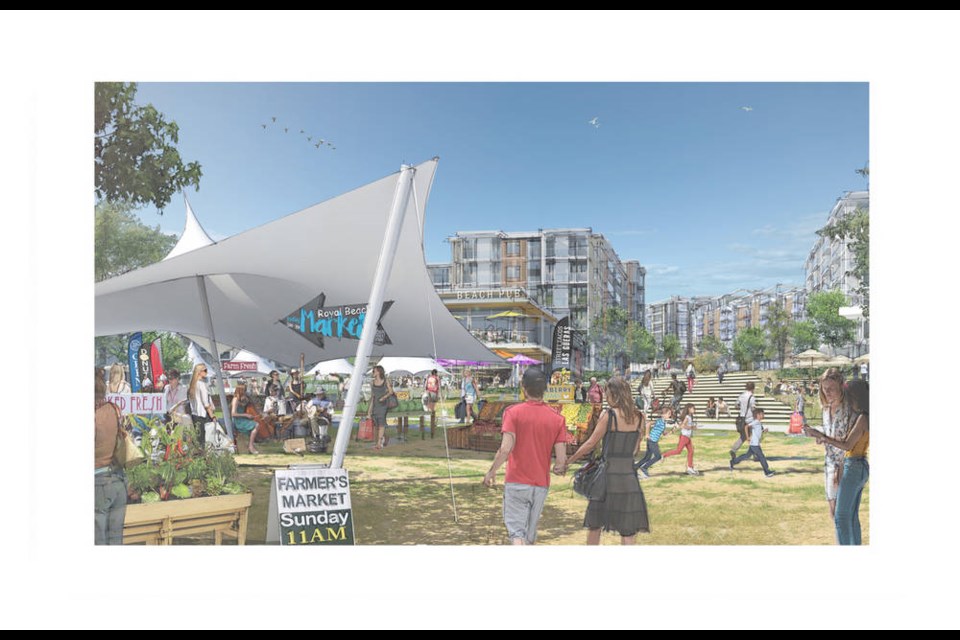Seacliff Properties’ plans for a mixed-use community with up to 2,850 homes on the site of a former gravel pit in Royal Bay has received initial support from Colwood council.
The Royal Beach project must still go to public hearing, and details of the development on the 134-acre site continue to be fine-tuned by municipal staff.
The proposal would see a range of housing types, commercial and office space, and parkland on the property, which runs east of Metchosin Road to the waterfront.
If the project is approved by council, construction of a restaurant-pub on the waterfront could start early in 2021, Seacliff asset manager Georgia Desjardins said Tuesday. “We are just anxious to get going with it,” she said.
On Monday night, council passed first and second readings of changes to its official community plan and land-use bylaw to allow the development.
Ideally, a public hearing would be held in late September or early October, Desjardins said. The entire development could take two decades to build out, Desjardins said.
Previous owners have planned for development of the former gravel-pit site. Vancouver-based Seacliff purchased its land in 2017, adjacent to property owned by Gablecraft Homes, where another proposed large mixed-use community is still awaiting final approval after council voted in favour following a public hearing in mid-July.
Together, the developments could see close to 5,000 new homes constructed in Colwood, which has been attracting new residential and commercial projects as construction booms on the West Shore.
Seacliff’s restaurant-pub would be in the site’s main retail and commercial hub, Desjardins said. A Latoria Road connection would run to the waterfront, where there would be smaller-scale, two-storey buildings with shops, services and a public plaza looking over the ocean.
After the restaurant-pub is built, additional mixed-use development, including residential, would go up at the seaside village, along with residential elsewhere on the property, Desjardins said.
At Monday’s council meeting, it was decided to allow 12-storey buildings on a sloped area near Metchosin Road only. A proposal for 12 storeys in the Landing neighbourhood was cut back to six storeys.
The developer and city staff will also be looking at setting a cap on non-residential space permitted in the southwest section of the site. The space could be used for a grocery store, hotels, education or office space, Desjardins said.
The goal is to have flexibility for the development to adapt to the market in future years, she said. “We see great opportunities for the site.”
Plans call for 50 acres of parks, trails and public land, including 10 sites for specific uses, such as fitness training, yoga or beach volleyball.
Coun. Doug Kobyashi told council he wants to ensure there will be enough public parking to make the site a destination. Staff said parking details are still being fleshed out with the developer.
At council’s request, city staff are drawing up reports on a wide range of issues, including parks, traffic, commercial space and servicing.
Seacliff’s plans are divided into three areas: the Bluffs, the Landing (which includes the pub and shopping area on the waterfront) and the Headlands.
The Landing, at the centre of the property, would have up to 1,850 homes, plus a maximum of 868,368 square feet (80,674 square metres) of non-residential use.
The Landing would also include space for a potential passenger ferry terminal.
At the Bluffs, a lower-density residential area with ground-oriented buildings is proposed, with a maximum of 750 homes, including apartments up to six storeys, 350 duplexes and townhouses in buildings up to three storeys, and a cap of 250 single-family homes. Additional commercial uses are also proposed in the Bluffs.
The Headlands would be strictly residential. A total of 250 homes would be allowed there, with attached dwellings of up to four stories and single-family homes of up to three storeys.



